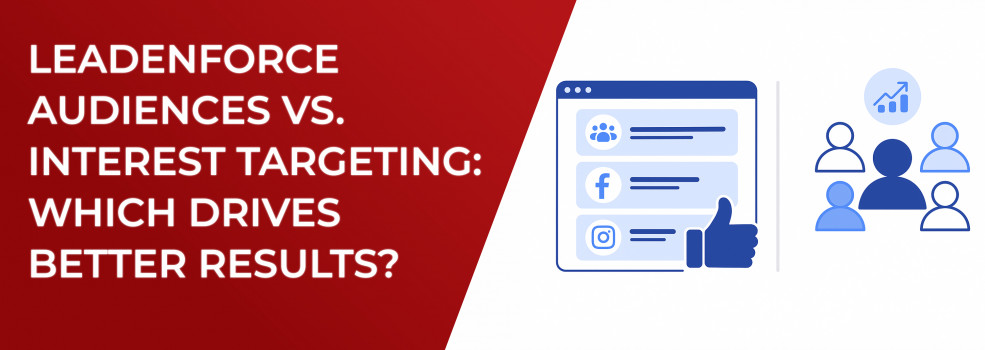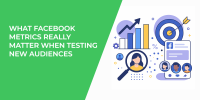Reaching the right target audience in advertising has never been harder, or more rewarding. New to Meta advertising? Check out our in-depth guide on Facebook Ad Targeting 101: How to Reach the Right Audience to ground yourself in the basics before diving into advanced tactics.
If you spend any time inside Meta Ads Manager you have probably run into two popular approaches:
-
Facebook interest targeting (also called “Facebook ads targeting interests”).
-
Custom ad audience targeting built with LeadEnforce.
Both approaches can deliver wins, but they work in very different ways. Below you will find a plain-English breakdown of how each system operates, why performance can diverge so widely, and how to decide which tactic deserves your budget next quarter.
What Is Facebook Interest Targeting?
New media buyers often start by asking, “how does Facebook interest targeting work?” Meta labels every user with thousands of interest signals, covering everything from “espresso” to “electric cars.” When you build a campaign you pick a cluster of those interests and let the algorithm handle the rest.
Why marketers like it
Speed, global scale and automated delivery are the three big reasons advertisers gravitate toward Facebook’s built-in interest targeting.
-
Speed — building an ad set with Facebook interest targeting options takes minutes.
-
Scale — there are interests for almost every niche, so you can launch worldwide campaigns fast.
-
Automation — Meta optimises delivery toward people most likely to click or convert.
Where it falls short
-
Fuzzy edges, because interests are inferred and users may only casually browse a topic.
-
Overlap, as competing brands hit the same segments and drive CPMs up.
-
Data decay, where outdated interests linger and cloud accuracy.
If you have ever wondered why some interest targeting Facebook ads reach people who would never buy, you have already met these limitations. If you are still mapping out exactly who you want to reach, our step-by-step framework on How to Define a Target Audience for Marketing will walk you through the process.
Enter LeadEnforce Audiences
LeadEnforce flips the script by creating custom audiences on Facebook sourced from real community signals:
-
Facebook group members – analyzes group participants.
-
Page followers – captures fans of niche or competitor pages.
-
Instagram followers – mirrors engaged IG users inside Meta Ads.
Building a LeadEnforce audience starts by pulling real followers and members, no guesswork required.
Because every profile in a LeadEnforce list has actively followed or joined something, you work with hard-proof intent instead of a probabilistic guess. Think of LeadEnforce as an audience targeting platform that turns social followership into a laser-focused seed list. For a deeper dive into seed selection, read Custom vs Lookalike Audiences: What Works Best for Facebook Campaigns?.
Performance Showdown
Average results from 18 e-commerce campaigns we ran in 2025 (fashion, coaching, and SaaS offers; budgets $1 000–$15 000):
-
Click-through rate (CTR)
-
Interest targeting: 0.78 %
-
LeadEnforce audiences: 1.42 %
-
-
Cost per mille (CPM)
-
Interest targeting: $14.20
-
LeadEnforce audiences: $11.10
-
-
Cost per acquisition (CPA)
-
Interest targeting: $38.50
-
LeadEnforce audiences: $27.40
-
-
Return on ad spend (ROAS)
-
Interest targeting: 2.3
-
LeadEnforce audiences: 3.6
-
Why the lift occurs
-
Higher relevance leads to stronger click-through because followers and group members recognise copy that speaks their language.
-
Less competition, as few advertisers mine micro-niche audiences, keeping auctions cheaper.
-
Better downstream learning — Meta’s conversion model thrives on clean data, and precise inputs unlock smarter lookalikes.
Speeding through Meta’s learning phase is the next hurdle — our playbook on How to Finish the Facebook Learning Phase Quickly shows exactly how to do it.
When to Choose Each Approach
Before you lock in your campaign plan, skim the quick decision map below. It shows the scenarios where each method shines so you can match the tactic to your specific goal and budget constraints. The platform never stands still — see the latest Facebook Ads Targeting Updates and How to Adapt in 2025 so you are judging these options with the freshest data.
Notice that Facebook ad targeting options are not an either-or decision. Many brands open with a LeadEnforce seed, then layer broader Facebook interest targeting tools in expansion campaigns once their pixel has learned.
Pro Tips for Blending Both Methods
-
Start narrow, then widen. Let LeadEnforce feed your first 500 conversions before testing “espresso lovers” or “digital nomads.”
-
Exclude overlaps. Use the “exclude audience” feature so targeted Facebook ads do not waste impressions on people already in your custom list. Follow the best-practice checklist in When to Use Exclude Targeting on Facebook and Why It Matters so your budgets never cannibalise each other.
-
Refresh lists monthly. Communities grow, so keep pulling new followers to avoid fatigue.
-
Stack creative angles. Ads that mention the group or page (for example, “Seen in Growth Hackers”) often score the cheapest clicks.
The Verdict
Interest segments remain a handy Swiss-army knife, but when profit margins matter, audiences anchored in real social connections usually win. LeadEnforce’s ability to mine Facebook group members, page fans, and Instagram followers gives performance marketers a data edge that broad, inferred interests cannot match.
If you are ready to upgrade from guesswork to laser-focused advertising audience targeting, start with a single LeadEnforce list today. Let the numbers guide you; chances are you will never look back.
Ready to see what those warm communities can do for your bottom line? Sign up for a free trial at LeadEnforce and build your first custom audience in minutes, with no code, no scraping headaches, just results.

